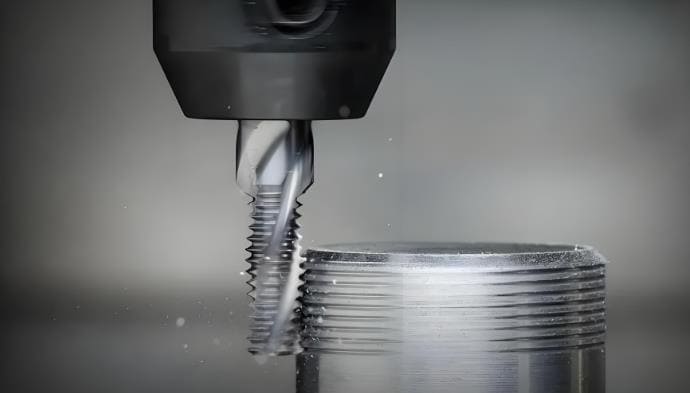CNC Tapping: Advantages and Process Introduction
CNC tapping is the automated process of cutting internal threads into pre-drilled holes using computer-controlled taps. It delivers precision threading by following programmed tool paths and controlled spindle speeds. This method is essential for industries that demand tight thread tolerances and high repeatability. CNC tapping integrates seamlessly into milling or drilling operations, reducing setup times and boosting overall workflow efficiency.
Thread Types and Material Considerations
CNC tapping supports a wide range of thread forms, including metric, UNC, UNF, NPT, and Acme threads. Each thread type requires selecting the correct tap geometry, drill size, and chamfer angle. Material hardness influences tap selection and cutting parameters: softer alloys allow faster feed rates, while harder steels need reduced speeds and peck tapping to avoid tool breakage. Proper coolant and lubricant choice prevents built‑up edge and ensures consistent chip evacuation.
Key Advantages of CNC Tapping
Precision and Consistency: CNC tapping yields uniform thread profiles across batches. Programs can be saved and reused, guaranteeing identical results on repeat jobs.
High Throughput: Automated tapping runs faster than manual operations, increasing production rates and reducing cycle times.
Reduced Scrap: Accurate control minimizes thread errors and scrap rates. Less rework lowers material waste and cost.
Enhanced Safety: Computer control limits operator interaction with sharp taps, reducing hand‑tapping accidents.
High Quality and Replicability
CNC tapping machines maintain tight tolerances, often within a few microns. This precision is critical for applications like aerospace and medical devices, where thread integrity is non‑negotiable. Automated depth control and synchronized feeds ensure every thread meets specifications, even in complex multi‑axis setups.
Speed and Productivity
Compared to manual tapping, CNC tapping can operate at spindle speeds of 40–200 RPM, depending on material and thread size. High‑speed tapping centers use rigid tapping to match spindle rotation with feed rates, eliminating backlash and overshoot. This synchronization cuts cycle times drastically, especially for large volumes of standard threads.

CNC Tapping Process Steps
Workpiece Setup: Secure the part using vises or fixtures to prevent movement. Ensure proper alignment to maintain thread perpendicularity.
Drilling/Boring: Drill to the correct tap‑drill diameter. Use peck drilling for deep holes to clear chips.
Chamfering: Deburr and chamfer the hole entrance to guide the tap and reduce thread defects.
Tapping: Load the appropriate tap holder. Program spindle speed, feed rate, and depth. Execute the tapping cycle—rigid or floating—according to part needs.
Inspection and Cleaning: Verify thread dimensions using gauges or CMM. Blow out chips and apply corrosion‑inhibiting oil if necessary.
Rigid vs. Conventional Tapping
Rigid tapping synchronizes spindle and axis movements for precise depth control. It outperforms conventional floating holders by eliminating the need for tension‑compression adapters. Rigid tapping reduces cycle times and tap wear. However, it requires a CNC control capable of synchronized motion. Conventional holders offer forgiveness for minor synchronization errors but run slower and may stress taps during direction reversals.
Best Practices
Tool Selection: Choose high‑quality taps and holders. Replace taps at signs of wear to maintain thread integrity.
Coolant Application: Use flood or through‑spindle coolant to reduce heat and flush chips.
Program Verification: Simulate tapping cycles in CAM software to detect collisions or feed errors.
Regular Maintenance: Keep machines and collets clean. Calibrate spindle and axes to prevent runout.
Operator Training: Ensure staff understand tool offsets, speed/feed optimization, and safety protocols.
Typical Applications
Aerospace: Landing gear and engine components require uniform, high‑strength threads.
Automotive: Transmission housings and cylinder heads demand fast, repeatable threading.
Medical Devices: Precision down to microns is critical for implants and surgical tools.
CNC tapping combines accuracy, speed, and repeatability to meet modern manufacturing demands. Its automated nature reduces errors and scrap, while rigid tapping option

